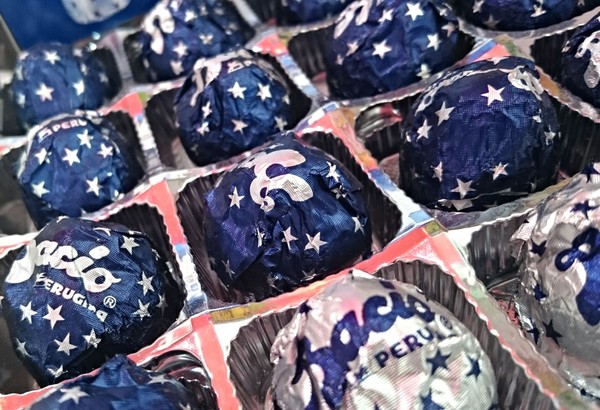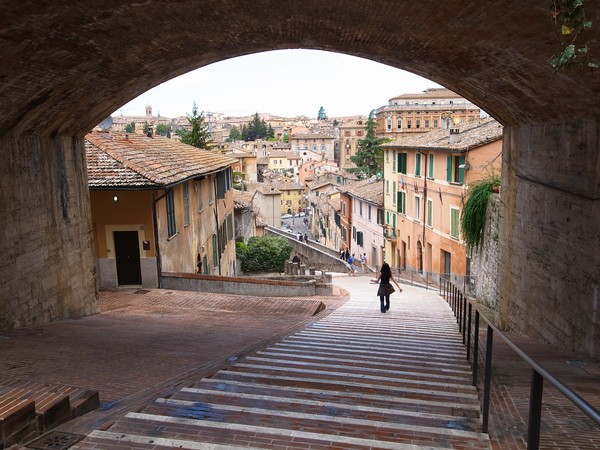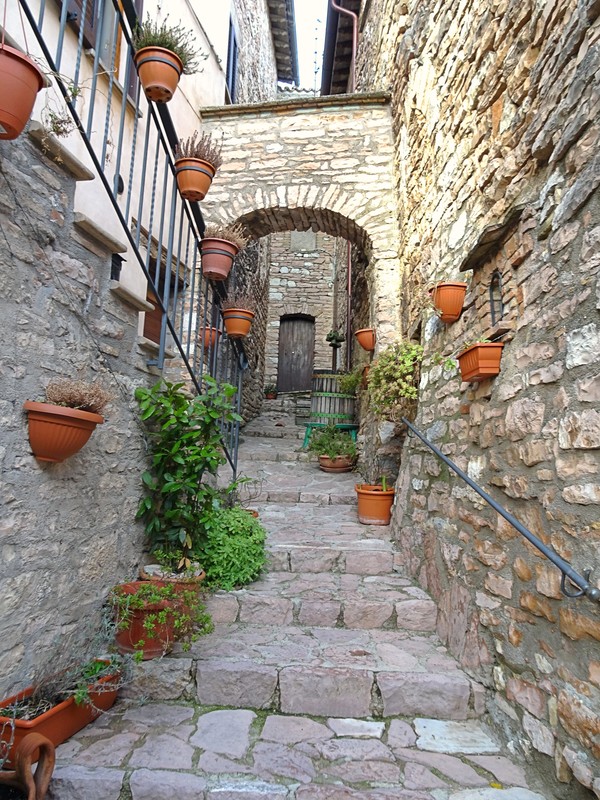PERUGIA

[아츠앤컬쳐] 이탈리아 중심부에 위치한 페루지아는 아름다운 자연환경을 자랑하며 예술과 문화의 도시로도 널리 알려져 있다. 그뿐만 아니라 페루지아는 아주 긴 역사를 보유하고 있는데, 이는 페루지아의 구시가지 곳곳에서 그 흔적을 찾아볼 수 있다. 페루지아의 역사는 에트루리아 시대인 B.C. 6세기까지 거슬러 올라가야 한다. 페루지아는 에트루리아인들의 주요 도시 중 한 곳으로 구시가지로 향하는 길을 여는 ‘에트루리아 문(Arco Etrusco)’이 그 시대를 보여주는 기념물이다.
페루지아는 마치 고대 중세 도시처럼 높낮이가 서로 다른 경사면으로 이루어져 도시에 들어서는 관광객들의 시선을 사로잡는다. 실제로 도시 성벽을 강화하고 탑(일부 역사가들에 의하면 원래는 70여 개가 존재했다고 한다)들이 증축되었던 중세 시대에 전성기를 맞이했다.

중세 시대를 대표하는 상징물로는 폰타나 마조레(Fontana Maggiore)가 있다. 폰타나 마조레는 흰색과 분홍색 돌로 제작된 이층 구조의 분수이다. 역사적, 신화적 에피소드가 그려진 조각상들로 장식된 분수는 언덕이 많은 페루지아의 지형적인 특성에도 불구하고 당시 혁신적인 기술인 수로(acquedotto)에 의해 도시로 물을 공급해 왔다. 오늘날에는 더 이상 수로에서 물이 공급되지 않지만, 여전히 이탈리아에서 가장 아름다운 산책로 중 하나로 여겨진다.
돌로 된 수로 상부 산책로는 마조레 분수가 위치한 11월 4일 광장(Piazza IV Novembre)으로 연결되는 아주 인상적인 길이다. 비대칭적이지만 영화 배경 같은 11월 4일 광장에 다다르면 도시에서 가장 중요한 건물들을 한 자리에서 만나 볼 수 있다. 우선 귀한 분홍색 대리석으로 장식된 산 로렌조 대성당(Cattedrale di San Lorenzo)의 측면 파사드를 감상할 수 있다. 또한, 시청사와 움브리아 국립 박물관이 있는 프리오리 궁전(Palazzo dei Priori)도 11월 4일 광장에 있다.
하지만 페루지아 방문 여정은 여기서 끝이 아니다. 외부의 습격으로부터 안전한 장소를 시민들에게 제공하기 위해 교황 바오로 3세가 지은 로카 파올리나(Rocca Paolina) 요새를 놓쳐서는 안 된다. 아쉽게도 처음 지어질 때의 모습을 그대로 유지하진 못 했지만, 로카 파올리나는 일종의 ‘매장된 도시’와 같은 지하 공간을 가지고 있어 관광객들의 매료시킨다. 이 공간에서는 일 년 내내 다양한 문화 행사가 열린다.

페루지아는 초콜릿 생산지로 유명한데 특히 전 세계적으로 사랑받는 ‘바치오 페루지노’(페루지안 키스) 초콜릿의 고향이다. 그래서 그런지 매년 10월, 페루지아에서는 유럽 전역에서 초콜릿 관련된 제조사와 가게들이 참여해 초콜릿 전시와 상품을 파는 아주 맛있는 ‘유로 초콜릿 축제’가 열린다.
주요 행사로는 ‘움브리아 재즈 페스티벌’도 빼놓을 수 없다. ‘움브리아 재즈 페스티벌’은 이탈리아에서 열리는 가장 중요한 재즈 음악 축제로 매년 7월 페루지아에서 열린다. 또한 페루지아에는 페루지아 대학교와 페루지아 외국인 대학교라는 두 개의 명문 대학교가 있다.
언뜻 보기에는 페루지아는 조용한 중세 시대 시골 마을 같은 모습을 하고 있지만, 문화적 차원에서 활력이 넘치는 놀라움이 가득한 도시다. 또한, 페루지아는 피렌체와 로마와 같은 다른 도시로 이동하기 좋은 이탈리아 중부 움브리아 주에 위치해 있어 여행 출발지로도 아주 좋다.
번역 | 신서현 주한이탈리아문화원 홍보담당

PERUGIA
Located in the heart of Italy and immersed in a wonderful natural setting, Perugia is famous for its art and cultural heritage. But that's not all. Perugia preserves thousand years of history, and it is visible in its historical center.
We have to go back to the 6th century BC. to trace its roots, that is, when the Etruscans chose Perugia as one of their capitals. Today the famous Etruscan Arch remains the most monumental access route to the historical center.
Once inside, you will be amazed by the atmosphere. Perugia stands on continuous slopes with different height, as if it were an ancient medieval village. In fact, the city saw its moment of maximum splendor in the Middle Ages, when the walls were fortified and the towers (originally 70, according to some historians) were raised.

Symbol of this era is certainly the Fontana Maggiore, a fountain consisting of two pink and white stone basins with statues that tell historical and mythological episodes. In ancient times it was fed by the aqueduct, an extraordinary engineering work for that time, which allowed water to be brought to the city despite its geography characteristics. Today it is no longer in operation, however it offers one of the most beautiful promenades in Italy. In fact, the upper area of the aqueduct is walkable and represents an impressive way to the fountain and the square in which it is inserted.
We are therefore talking about Piazza IV Novembre, with an asymmetrical but scenographic appearance, overlooked by the most important buildings in the city. First of all, you can admire the side facade of the Cathedral of San Lorenzo from here, with its precious pink marbles.

Another building of great importance is the Palazzo dei Priori, an imposing example of Gothic architecture. It is the center of the municipal life of the city, because the Municipality of Perugia is based here, also the National Gallery of Umbria, which has one of the most complete and richest artistic heritages in the whole region.
But the visit does not end here. Another stop not to be missed is the Rocca Paolina, an ancient fortress built by Pope Paul III to offer a safe place to the city in the event of an enemya rid. The most suggestive part’s of the fortress is certainly the underground. It is a sort of "buried city", which lends itself to various cultural events throughout the year.

Perugia is also a well-known cultural and artistic centre of Italy. The city hosts multiple annual festivals and events, such as Eurochocolate Festival hold every October, it is the European chocolate festival and it not a coincidence that Perugia is also very known for the delicious chocolate called “bacio Perugino”(perugian kiss); the Umbria Jazz Festival hold every July, it is the most important Jazz Festival in Italy. Moreover at Perugia, two prestigious universities are located there, the University of Perugia and the University for Foreigners of Perugia.
In short, despite the appearance of a quiet village from the past, Perugia is a surprisingly vital city, especially at a cultural level. Furthermore, being located in the heart of central Italy(Umbria), it is perfectly suited as a starting point for traveling to the rest of the region but also for reaching other places in the country, such as Florence or Rome.

글 | 미켈라 린다 마그리 Michela Linda Magrì
Director at the Italian Cultural Institute in Seoul
Cultural Attachè of the Embassy of Italy in Korea

